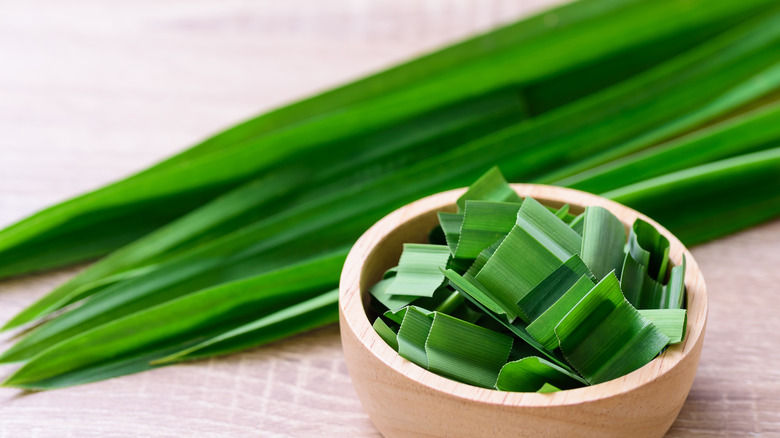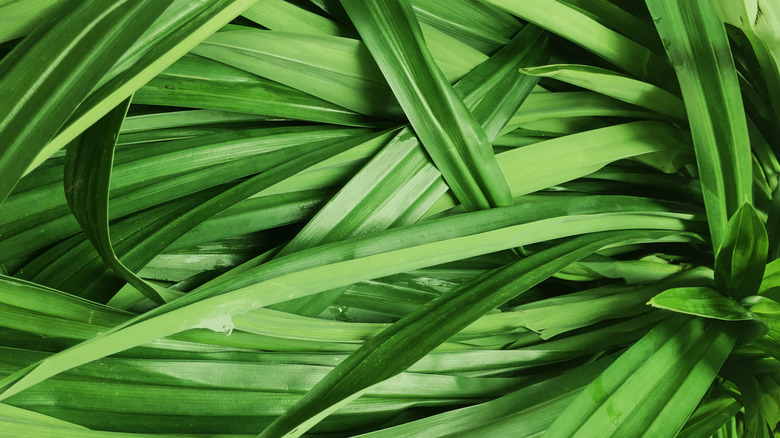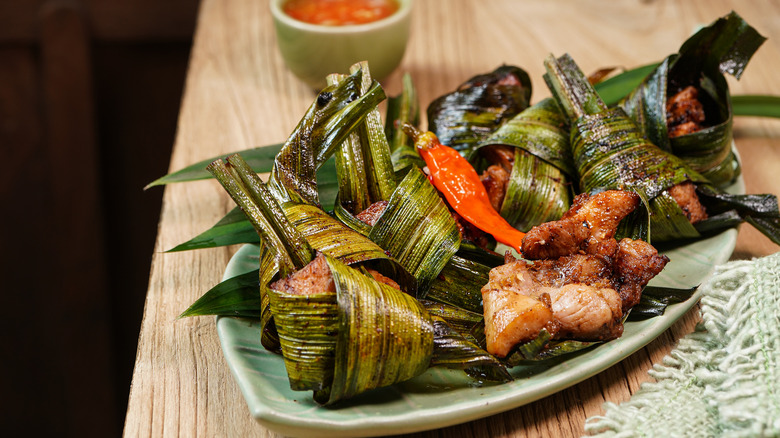The Ingredient That Gives Pandan Chiffon Cake Its Bright Green Color
Herbs, aromatics, and flavorings are often categorized as sweet or savory with very little crossover between these flavor profiles, but other than a personal bias, there may not be an actual culinary reason for that. Garlic has been used with some success as an ingredient in cakes and cookies, while some food cultures like South Africa are happy to use vanilla to prepare their beef stew and seafood dishes. A third example of a crossover herb is pandan or screwpine — the versatile leaf that is used to make just about everything in Southeast Asia.
Pandan leaves are sweet smelling, and have been referred to as "the vanilla of Southeast Asia." Tea extracted from pandan leaves can be served as a refreshing beverage. It is used to flavor desserts, and the brilliant green of pandan extract is why the chiffon cake that bears its name is colored green that way. The herb is what gives Malaysian nasi lemak its distinctive aroma, and pandan is the herby wrapper that makes Thai fried chicken or gai hor bai toey so moreish. In fact, Southeast Asian food wouldn't be what it is without pandan, which is widely used in recipes from Indonesia, Malaysia, the Philippines, Singapore, Thailand, and Vietnam.
Pandan is easy to grow
The leaves of the pandan plant are thin, long, and thorny. They can measure up to 20 inches. It doesn't have any flowers or bear any fruit; the only way to grow the plant is through cuttings, although it can also appear as tree suckers, per Singapore Infopedia. Also known as pandanus amarylliflolius, it is speculated that pandan could have its roots (literally) in the Moluccas since the only variant of this plant that grows flowers can be found there. It is then believed to have crossed over into Southeast Asia and Sri Lanka with the help of traders or travelers, who carried it to the region. Exactly when this happened is unclear, although Michelin says the plant has been a feature in Thailand's culinary landscape for hundreds of years, during its Ayutthayan Period.
The absence of any fruits or flowers hasn't prevented pandan from thriving wherever it is planted, and today, Michelin says the plant grows "like weeds" in the tropical region where it is prized, not just for its flavor, but also for its nutritional value. Healthline says pandan paste is packed with beta-carotene and is full of iron and calcium. Small studies have shown pandan can be used as an ointment to relieve pain caused by arthritis, and when it is made up as a tea, it can even help manage blood sugar. However, there is a risk in consuming too much pandan, as it can also be a mild laxative.
Pandan can be used in different ways
The way pandan is used depends entirely on what you happen to be cooking. When it is used to perfume rice, the long pandan leaves are usually tied into a knot and tossed into the rice pot, so it can be retrieved when the cooking is done. To make pandan chicken, pandan leaves are de-spiked, used whole, and are either turned into a pocket, or wrapped tightly around generous chunks of marinated boneless chicken thighs or breasts, and held with long toothpicks.
And when there is a need to cook with pandan extract, the choice is to buy commercial extract or make fresh pandan extract at home. To do the latter, Singapore Women's Weekly says to start by topping and tailing the leaves, then cut them into short strips, add a half cup of water, and blend until smooth. Strain the extract before using; any leftovers can be saved for up to three days. King Arthur says both fresh and frozen pandan leaves can be found at Asian supermarkets, but if you want to buy pre-made pandan extract or pandan paste, read its labels carefully to ensure that you're picking up something that isn't made with artificial flavors and colors.


